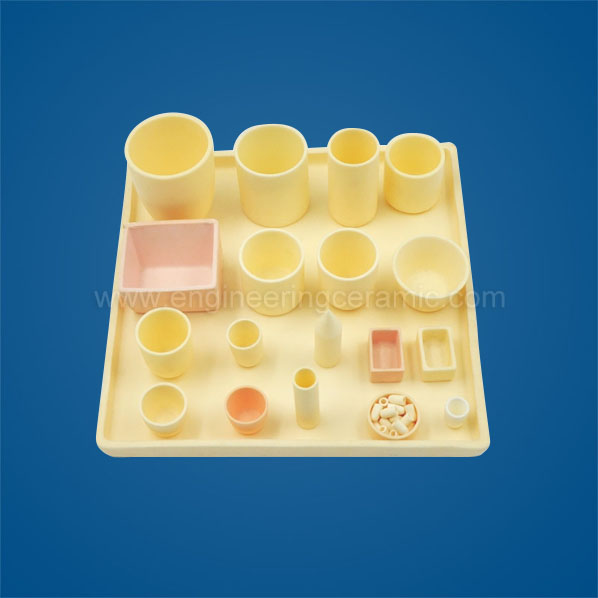Exploring the Benefits and Applications of Alumina Ceramic Labware
2025-02-12
Alumina ceramic labware is a critical component in many laboratories, offering superior durability, precision, and resistance to harsh environments. Known for its high purity and excellent thermal and electrical properties, alumina ceramics are increasingly being used across various scientific fields. In this blog, we will explore the features, advantages, and diverse applications of alumina ceramic labware, as well as why it is considered an essential material for modern laboratory work.
What is Alumina Ceramic?
Alumina, also known as aluminum oxide , is a ceramic material made from aluminum and oxygen. It is one of the most widely used ceramics in the world due to its excellent mechanical, electrical, and thermal properties. Alumina ceramics are highly resistant to wear and corrosion, and they can withstand extreme temperatures, making them ideal for laboratory applications.
Alumina ceramic labware includes various tools such as crucibles, dishes, trays, trays, tubes, and specialized components that are used in scientific experiments, chemical analysis, and high-temperature processes. These pieces of equipment are manufactured by processing alumina powder into solid forms, which are then sintered at high temperatures to produce strong, durable ceramic objects.
Key Features of Alumina Ceramic Labware
1. High Durability
Alumina ceramics are known for their exceptional strength and hardness. This makes them highly durable and resistant to scratching, chipping, and breaking, even in the most demanding laboratory environments. Their resilience makes them suitable for use in both high-volume and high-temperature applications.
2. Superior Thermal Stability
One of the standout features of alumina ceramics is their ability to withstand extreme temperatures. They are stable at temperatures exceeding 1,600°C, which makes them ideal for use in applications that involve high heat, such as chemical processing, metalworking, and certain laboratory experiments.
3. Chemical Resistance
Alumina ceramics offer excellent resistance to chemical corrosion, making them a popular choice in laboratories where they may be exposed to a variety of reactive substances. Whether dealing with acids, alkalis, or solvents, alumina labware remains unaffected, ensuring that the equipment lasts longer and the results of experiments are not compromised by contamination.
4. High Purity
Alumina is known for its high purity levels, which is crucial for many scientific applications. High-purity alumina ceramics help to ensure that there is minimal interference with chemical reactions and that experimental results are as accurate and reliable as possible. This is especially important in fields like analytical chemistry and biochemistry.
5. Electrical Insulation
Alumina ceramics are excellent electrical insulators, which is particularly beneficial in laboratory settings where electrical isolation is required. This property makes alumina labware ideal for use in electronic testing, materials science experiments, and high-voltage applications.
Benefits of Using Alumina Ceramic Labware
1. Enhanced Performance and Precision
Alumina ceramic labware helps improve the accuracy and precision of laboratory experiments. The materials are non-reactive and provide stable conditions for chemical reactions. With alumina labware, scientists and researchers can ensure that no unwanted reactions or contaminations occur during experiments, leading to more reliable and reproducible results.
2. Cost-Effective
While alumina ceramics may have a higher initial cost compared to some other materials, their long lifespan and durability provide significant cost savings in the long run. Their resistance to wear and corrosion means they do not need to be replaced frequently, reducing overall maintenance costs.
3. Improved Safety
Alumina ceramics' resistance to high temperatures and chemical corrosion means they can handle harsh environments without breaking down or causing safety hazards. This makes them an ideal choice for laboratories that deal with toxic or hazardous substances. Using alumina labware reduces the risk of contamination and ensures a safe working environment.
4. Versatility
Alumina ceramics can be manufactured in a wide range of shapes and sizes to meet the specific needs of various laboratory tasks. Whether you need crucibles for high-temperature reactions, trays for chemical analysis, or tubes for precise measurements, alumina labware can be customized to suit the application. This versatility makes it suitable for a wide range of scientific disciplines, including chemistry, physics, biology, and materials science.
Applications of Alumina Ceramic Labware
1. Chemical Analysis
Alumina ceramics are extensively used in chemical laboratories for a variety of tasks, including chemical reactions, sample preparation, and storage of reactive substances. Alumina crucibles are often used in high-temperature experiments to heat and melt metals and other compounds. They are also used for burning samples in combustion analysis, where precision and resistance to chemical reactions are crucial.
2. High-Temperature Processes
Due to their excellent thermal stability, alumina ceramic labware is perfect for use in high-temperature processes such as sintering, calcining, and metal casting. They can withstand the extreme temperatures required for these processes without deforming or losing their structural integrity.
3. Materials Science
In materials science laboratories, alumina ceramics are used for creating test samples and for performing experiments that involve the manipulation and testing of various materials. Their high purity and resistance to chemicals make them ideal for investigating the properties of metals, alloys, and other materials.
4. Semiconductor and Electronics Testing
Alumina ceramic labware plays a critical role in the semiconductor and electronics industries, where it is used for testing materials, components, and systems. Alumina's insulating properties help to prevent electrical interference, making it a perfect material for use in testing environments that involve sensitive electronic devices and circuits.
5. Pharmaceutical Research
In pharmaceutical research, alumina ceramics are used for drug formulation, chemical testing, and other critical laboratory processes. The high purity of alumina ensures that the materials remain uncontaminated, which is essential for the accuracy and safety of pharmaceutical research.
Conclusion
Alumina ceramic labware is a versatile and essential material in modern laboratories. Its unique combination of durability, thermal stability, chemical resistance, and high purity makes it an invaluable tool for scientists and researchers across a variety of fields. Whether for high-temperature processes, chemical analysis, materials science, or electronics testing, alumina ceramics provide the reliability and precision needed for success. With their ability to withstand harsh conditions and their long-lasting performance, alumina ceramic labware is an investment that continues to deliver value in laboratory settings worldwide.



